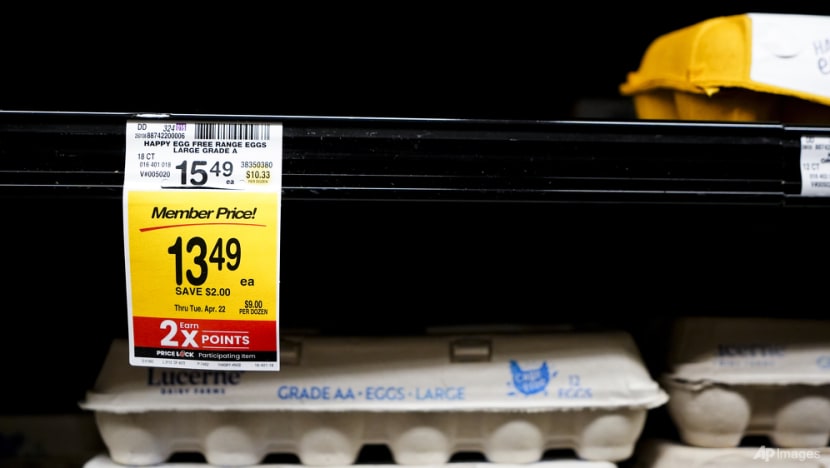Commentary: US egg prices are a problem. So where are the solutions?
The bird flu has created a crisis for farmers and consumers, while Elon Musk and Donald Trump have slashed the agency trying to fight the virus, says Bloomberg Opinion’s Patricia Lopez.

An empty shelf of free range eggs is seen at US supermarket chain Safeway on Jan 27, 2025, in Seattle. (AP Photo/Lindsey Wasson)
ST PAUL, Minnesota: During the presidential campaign, nothing captured Americans’ dissatisfaction with inflation as succinctly as the price of eggs. As a candidate, President Donald Trump repeatedly said that “When I win, I will bring prices down on Day 1.”
Of course, that has not happened. Instead, eggs cost more than ever. Denny’s and Waffle House are adding egg surcharges to their menus and many grocery store shelves are empty.
Avian flu has hit US egg producers hard. Farmers have been forced to kill off more than 150 million of their egg-laying hens, limiting supply and sending prices soaring.
The blame for an outbreak that started in 2022 cannot be laid fully at the feet of an administration barely in its sixth week. But it is Trump’s problem now. And so far, he has only made matters worse.
DISRUPTED FLU SURVEILLANCE PROGRAMME
The US historically had the strongest avian flu surveillance programme in the world, through the US Department of Agriculture’s (USDA) Animal and Plant Health Inspection Service. It is one that farmers in Iowa, Ohio, Indiana and Pennsylvania – which together produce almost half of the eggs in the country – have relied on to guide them through this outbreak.
Last week, the department acknowledged that the mass firings included an unconfirmed number of people working on the bird flu response – a stunning display of bureaucratic incompetence. Officials now are scrambling to find and rehire them.
Meanwhile, egg prices keep going up; they are up 53 per cent compared to a year ago and 15 per cent since January. The average price of a dozen eggs reached a new high of US$4.95 in the last month. And the cost is far more in some places – in Wisconsin, for example, a carton of pasture-raised eggs can set consumers back US$10. Some grocery stores have imposed limits on how many cartons customers can buy.
The toll on farmers has been staggering. They must pay not only the cost of culling their flocks, but replacing them with healthy stock. They bear the cost of disposal of dead hens and for the enhanced biosecurity measures recommended by the USDA. They face growing losses and even greater uncertainty about the future.
The magnitude of the egg shortage is even complicating matters at the US-Mexico border, which Trump has made a point of trying to secure. Customs and Border Protection agents are finding evidence of a rising black market in eggs. Confiscation of eggs at ports of entry has increased 29 per cent compared with the same time last year.
A POLITICAL PRICE TO PAY?
None of this appears to represent a political problem for Trump – yet. But only 32 per cent of Americans approve of Trump’s handling of high prices, according to a recent Reuters/Ipsos poll.
And there will be political hell to pay if the bird flu mutates to become a human outbreak, something almost half of Americans are already worried about. So far there have been 70 cases of humans contracting the virus from farm animals, along with one death. To date there have been no cases of human-to-human transmission in the US.
What is to be done? The long-standing US strategy of euthanising millions of birds has failed to contain the spread. New solutions are necessary – but they will not be easy to sell to farmers.
Trump, who favours quick, bold, short-term solutions, has reached out to Türkiye (one of the few countries with whom he still has good relations) and arranged to buy 15,000 tonnes of eggs. That may ease egg prices temporarily, but American farmers, who are watching their flocks and their profits decline, won’t be too happy.
Farmers may not be enthusiastic about the longer-term solution either: Vaccinations. Vaccinating flocks would add expense and complexity, but immunisation may be necessary.
The USDA has given conditional approval to a new bird flu vaccine developed by Zoetis, the world’s largest producer of livestock medications. Other countries, including China, Mexico, France, Vietnam and others already routinely vaccinate domestic flocks against the virus.
Other options, like changing how eggs are farmed, would also be unpopular with many large-scale farming operations. Jason Amundsen at Locally Laid in Wrenshall, Minnesota, expressed a view common among smaller-scale operations.
“We subscribe to the idea that when you put 30,000 birds in a barn that’s part of a complex of 3 million, you’re asking for pathogens,” he told me. “The birds’ immune systems don’t have a chance.” But most US eggs come from such mega farms and changing how eggs are produced is likely to meet industry resistance.
However difficult the solutions, none can proceed until the Trump administration invests more in the USDA’s avian flu work. It is too important to derail or curtail.
Accidentally firing bird flu specialists in the midst of an avian influenza pandemic is just one of many instances that prove why – unlike with Silicon Valley start-ups – “move fast and break things”, is unworkable when it comes to the federal government. The stakes of failure or guessing wrong are just too high.

















